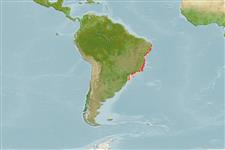Environment: milieu / climate zone / intervalo de profundidade / distribution range
Ecologia
marinhas associadas(os) a recifes; não migratória; intervalo de profundidade 0 - 30 m (Ref. 7247). Tropical; 6°S - 30°S, 50°W - 31°W
Western Atlantic: Brazil. Caribbean (described from Cuban specimens) species refers to Stegastes xanthurus (formerly considered as a junior synonym of S. variabilis). Populations from Brazil and the Caribbean are genetically very distinct (Roberstson & van Tassell, 2012; accessed 08 August 2016; http://biogeodb.stri.si.edu/caribbean/en/thefishes/species/3884).
Tamanho / Peso / Idade
Maturidade: Lm ? range ? - ? cm
Max length : 12.5 cm TL macho/indeterminado; (Ref. 9626)
Descrição breve
Chaves de identificação | Morfologia | Morfometria
Espinhos dorsais (total) : 12; Raios dorsais moles (total) : 14 - 17; Espinhos anais: 2; Raios anais moles: 12 - 15. Caudal fin slightly forked, with rounded lobes. Dark brown or blue above, shading to yellow below. Narrow, dark, obliquely vertical lines on side. Snout and forehead have bright blue lines. Small dark spot in pectoral axil, another on top of caudal peduncle (Ref. 26938).
Body shape (shape guide): short and / or deep; Cross section: compressed.
Adults inhabit inshore and offshore coral reefs. They feed mainly on benthic algae but also on sponges, ascidians and anemones while juveniles feed on invertebrates like harpacticoid copepods and nemerteans (Ref. 9626). Often solitary (Ref. 9626). Juveniles are aggressively territorial (Ref. 9626). Aggressive when breeding (Ref. 9710). Oviparous, distinct pairing during breeding (Ref. 205). Eggs are demersal and adhere to the substrate (Ref. 205). Males guard and aerate the eggs (Ref. 205). Taken incidentally in traps and small-meshed beach nets (Ref. 5217).
Life cycle and mating behavior
Maturidade | Reprodução | Desova | Ovos | Fecundidade | Larvas
Oviparous, distinct pairing during breeding (Ref. 205). Eggs are demersal and adhere to the substrate (Ref. 205). Males guard and aerate the eggs (Ref. 205).
Allen, G.R., 1991. Damselfishes of the world. Mergus Publishers, Melle, Germany. 271 p. (Ref. 7247)
Categoria na Lista Vermelha da IUCN (Ref. 130435: Version 2025-1)
Ameaça para o homem
Harmless
Utilização humana
Pescarias: espécies comerciais; Aquário: Espécies comerciais
Ferramentas
Relatórios especiais
Descarregue XML
Fontes da internet
Estimates based on models
Preferred temperature (Ref.
123201): 22.5 - 27.5, mean 25.9 °C (based on 139 cells).
Phylogenetic diversity index (Ref.
82804): PD
50 = 0.5000 [Uniqueness, from 0.5 = low to 2.0 = high].
Bayesian length-weight: a=0.01660 (0.00919 - 0.02998), b=2.99 (2.83 - 3.15), in cm total length, based on LWR estimates for this species & Genus-body shape (Ref.
93245).
Resiliência (Ref.
120179): Elevada, tempo mínimo de duplicação da população menor que 15 meses (Preliminary K or Fecundity.).
Fishing Vulnerability (Ref.
59153): Low vulnerability (10 of 100).
🛈
Nutrients (Ref.
124155): Calcium = 103 [52, 161] mg/100g; Iron = 0.741 [0.459, 1.216] mg/100g; Protein = 18.1 [17.0, 19.3] %; Omega3 = 0.11 [0.07, 0.18] g/100g; Selenium = 25.1 [13.9, 46.7] μg/100g; VitaminA = 81.5 [21.8, 278.2] μg/100g; Zinc = 1.75 [1.19, 2.54] mg/100g (wet weight);
